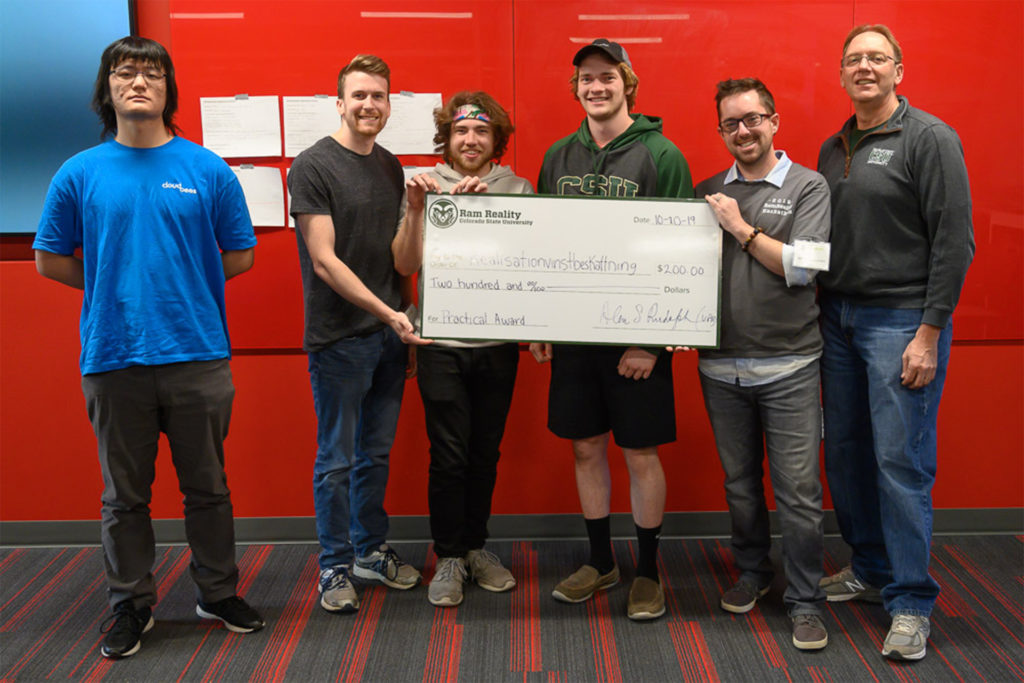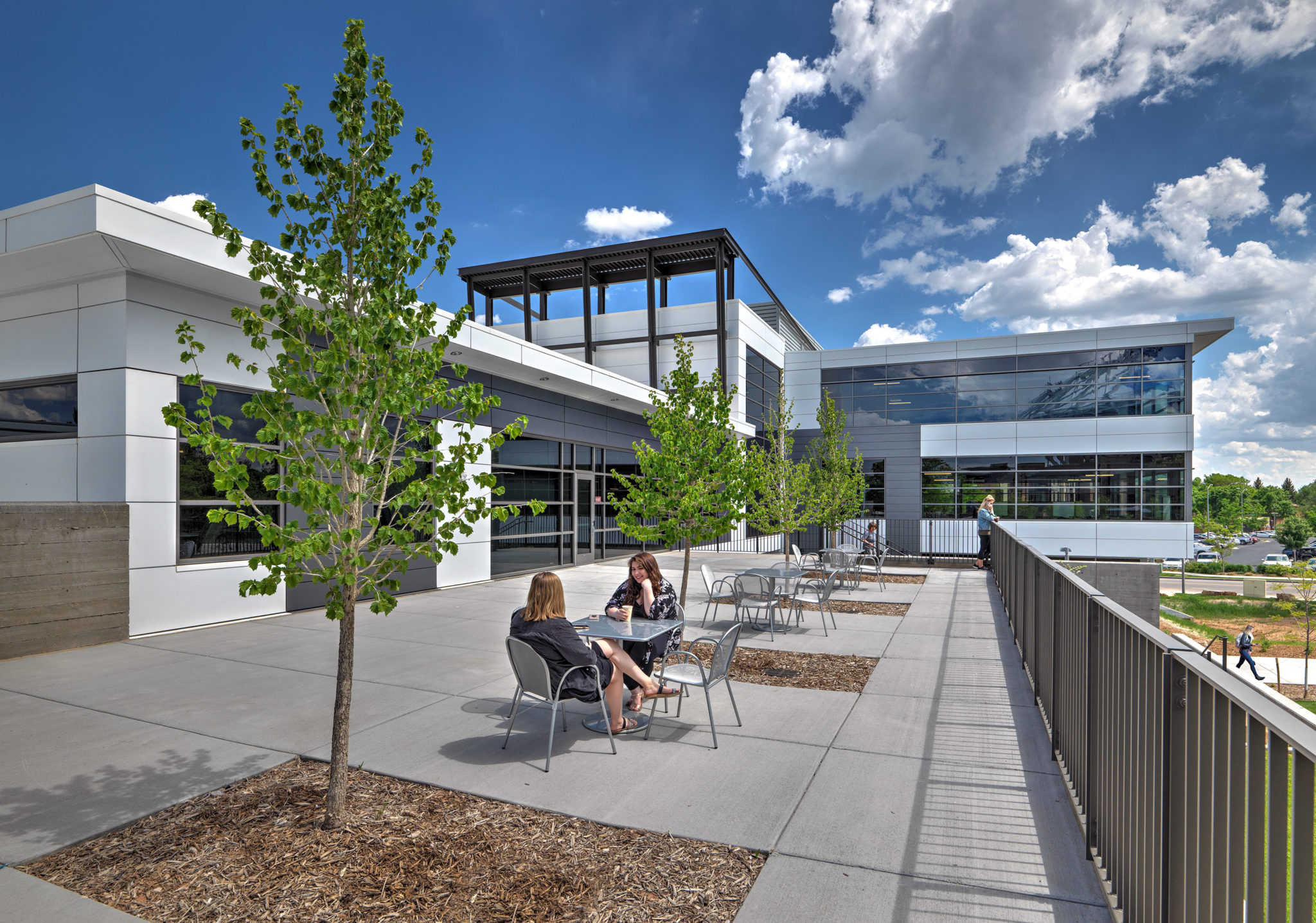It all started with the idea that buildings like the Nancy Richardson Design Center have a lot of intention behind their design. Now, a team of researchers and students are working to better inform users of how this and other buildings can improve their well-being and the environment.
The American Society of Interior Designers (ASID) is funding Leah Scolere (PI), assistant professor in the Department of Design and Merchandising, and Laura Malinin (co-PI), associate professor in the Department of Design and Merchandising and director of the RDC, to study how augmented reality, known as AR technology, can assess effectiveness of building design strategies intended to enhance occupant learning, creativity, and health and well-being.
As part of the grant, Scolere and Malinin are working with collaborators Francisco Ortega, associate professor in Computer Science, Jeni Cross, professor in Sociology and research director for the Institute for the Built Environment, and a student team to develop an AR app which users can install on their phone to find out more about the features of the building. Using this app and their phone camera, the AR technology will overlay digital elements on top of a live view of their physical environment.
“There are very few interior design focused grants, and we’re very honored to receive this funding when there is so much competition for it,” said Malinin.

Well-being in the RDC
The Nancy Richardson Design Center is designed to meet LEED-Gold standards for sustainable practices and the WELL building standards for improved human health and wellbeing.
That mission for a building that is good for both people and the environment can be seen in countless places throughout the RDC. The studios have dimmable and temperature changing LED lighting for when students work late into the evening. It’s better for their sleep cycle to shift the lights to the warmer tones in the evening.
Not only that, but the lighting in the RDC enables students to learn more about lighting in their courses. Even the exposed infrastructure in the ceilings provides students the opportunity to learn about how buildings are designed and built. It’s these spots for experiential learning that make the design center an academic incubator facility.
The Nancy Richardson Design Center, like many new buildings, will be undergoing a Post-Occupancy Evaluation. A POE is a survey that occupants take after moving into a building to measure user satisfaction with the spaces. The team intends to use AR technology to improve user’s awareness of the design center’s features and to potentially better inform users of other buildings.
“We have to ask ourselves how this research will impact future POEs we conduct across the industry,” said Scolere.
Developing the app

The team plans to use the AR technology to compare the standard POE with a more interactive experience.
“We wanted engagement,” said Malinin. “This project gives us the opportunity to not just ask for users feedback, but to also share information about the intent behind the building. Hopefully, we can nudge building users to take certain actions.”
For example, it could be taking the stairs, a key feature of the well-building standards that the RDC was designed to fulfill. That beautiful, red, open stairwell crossing the center of the building was placed there with the purpose of encouraging users to increase their physical activity.
Many of the questions Scolere and Malinin are considering for the AR application touch on collaboration, creativity, health, and wellness. Using the POE as a base, they want to add a module around how buildings can improve learning.
“Once you answer the question in the app it’ll pop up with additional information. If you’re using the AR, that graphic or text would be overlaid on top of the physical environment,” said Malinin.
Scolere and Malinin will be comparing the informative values of the traditional survey and the effectiveness of the AR experience through two focus groups. This will investigate whether the information is resonating with users and if it’s changing their behavior.
“Hopefully, we can use this to rethink and expand the POE process in the future,” said Scolere.
Collaborating with students

At the same time that Scolere and Malinin were awarded the ASIDF grant, the RDC hosted the CSU Vice President for Research Office’s RamReality Hackathon. Of the many proposals submitted, the RDC’s AR experience was selected by a team of students who went on to win the Practicality Award in the Hackathon. Scolere and Malinin have since collaborated with students from Team Real to develop their research.
“AR technology is very new, and our team gets to work with this expanding field,” said Jarret Flack, a graduate student in computer science from Team Real. “This project will allow all of us on the team to experience what it takes to develop a full-scale experience for real users.”
For Jeffrey Tousignant, an interior architecture and design major, first generation student, and combat veteran, one of the most important parts of this experience has been the ability to give back to his college. Additionally, working with this project has given him valuable experience working with POEs and engaging with the leading edge of the industry.
“I have been looking for an entry into computer science and its applications to design. AR research will be the conduit between Building Information Modeling and computer sciences,” said Tousignant.
William Schmitz, an electronic arts major from Team Real, said this project gave him a great opportunity to grow in an interdisciplinary environment and “work collaboratively with students from diverse backgrounds.”
Team Real will continue their work co-designing and implementing the AR application as Scolere and Malinin move forward on this project. Together, they will spend spring semester working on conceptualizing and developing the AR app for use by students and visitors in the RDC.
The Department of Design and Merchandising is in CSU’s College of Health and Human Sciences.

